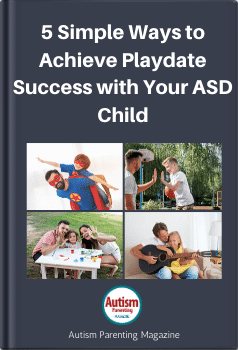Play is a crucial a part of childhood improvement, providing alternatives for studying and connection. For a lot of youngsters, together with these on the autism spectrum, autism parallel play will be an necessary developmental stage.
However what precisely is parallel play, and the way does it profit autistic youngsters?
Obtain your FREE information on
5 Easy Methods to Obtain Playdate Success with Your ASD Youngster
What’s parallel play?
Parallel play is when youngsters play subsequent to one another however don’t work together or play collectively. They is perhaps doing comparable actions, however they don’t have any actual engagement. In neurotypical youngsters, this normally begins round two to a few years previous.
It’s a improvement milestone that finally results in extra social play, like enjoying collectively or collaborating on video games.
Parallel play and autism
Parallel play will be deeply significant for autistic youngsters. It permits them to watch, be taught, and have interaction with their surroundings at their very own tempo with out the strain of direct social interplay.
Kids with autism usually exhibit traits that naturally align with parallel play. As an example, many have a choice for structured or repetitive actions.
In a parallel play setting, a toddler may give attention to constructing blocks or sorting toys whereas one other youngster engages in an analogous exercise close by. This shared however unbiased play provides alternatives for connection and studying whereas respecting their want for private area.
An actual-life instance could possibly be a toddler who enjoys organizing toy vehicles by colour. They might sit beside one other youngster, arranging puzzles. Whereas no direct interplay happens, the proximity helps construct familiarity and luxury with others.
Parallel play may function a stepping stone for growing communication abilities. For instance, an autistic youngster may progressively start to imitate a peer’s actions, similar to stacking blocks in the identical approach.
This shared expertise can open doorways to nonverbal communication, similar to shared glances or smiles.
Advantages of parallel play for autistic youngsters
Parallel play has many advantages for autistic youngsters and their improvement. Kids are nonetheless conscious of one another regardless of indirectly interacting.
Being close to friends may help autistic youngsters turn out to be extra snug in the identical area, permitting for coexistence. Autistic youngsters may really feel extra snug enjoying close to their friends for a lot of causes.
Play how they need
Many autistic youngsters love construction or repetitive actions. Parallel play lets them persist with their routines with out adjusting to how another person may wish to play.

For instance, an autistic youngster may sit close to a peer enjoying with vehicles however give attention to lining up their vehicles in a row as a substitute of becoming a member of in on a fake race. Each are enjoying, simply in ways in which really feel proper for them.
Play with out strain
Kids engaged in parallel play observe how different youngsters play and their social interplay with out the strain to hitch. This statement helps them be taught by imitation.
For instance, they may see one other youngster stacking blocks in a particular approach or utilizing a toy creatively after which resolve to attempt it themselves. They may see one other peer pretending to be a superhero after which, impressed by that, do the identical.
Creativeness helps with creativity and aids in cognitive development as they be taught to assume past the concrete and into the summary. Imitating friends on this approach helps them observe new abilities with out the strain of interacting socially.
Social engagement
As a result of social communication will be tough for autistic youngsters, they could really feel much less strain to select up on social cues after they parallel play.
They may observe how others use verbal and nonverbal communication, similar to gestures, facial expressions, or physique language.
For instance, if one youngster asks for a toy and the opposite fingers it over, the kid watching sees how easy communication works in play. They may begin to imitate this in a while after they really feel extra assured.
Group dynamics
Parallel play may help help the understanding of group dynamics. By watching how teams of kids play collectively, an autistic youngster can start to grasp the move of social interplay.
For instance, they may see a gaggle of youngsters working collectively to construct blocks or have interaction in fake play. Although they’re indirectly concerned, they’re nonetheless absorbing these social patterns.
Think about an autistic youngster quietly stacking blocks whereas different youngsters play close by with a toy kitchen set. The kid watches as one youngster pretends to prepare dinner and one other “orders meals.”
Although they’re indirectly enjoying with the group, they’re observing how the fake play works, how their friends talk, and the way everybody takes turns.
Parallel play creates a protected surroundings for kids with autism to watch social situations in a approach that feels much less overwhelming. Over time, these observations can result in actual development in social abilities and confidence.
Confidence constructing
Parallel play permits youngsters to discover at their very own tempo, serving to them construct confidence of their distinctive skills and strengths.
It provides autistic youngsters the liberty to have interaction in actions that curiosity them with out having to comply with another person’s guidelines or expectations.
This independence permits them to discover their toys, supplies, or environment uniquely, sparking creativity.
For instance, whereas enjoying with blocks, a toddler may construct a construction totally based mostly on their creativeness, experimenting with completely different shapes and designs.
Ability improvement
Parallel play can help with the event of particular abilities. It might probably additionally help language improvement. Autistic youngsters might observe their friends identify gadgets and have interaction in back-and-forth verbal interplay.
Enjoying side-by-side may assist government perform. The autistic youngster can observe how different youngsters method duties and resolve issues.
If a peer builds a construction with blocks, the autistic youngster may discover how they plan the bottom and stack the blocks in a specific order.
The autistic youngster can be taught necessary planning and problem-solving methods just by observing, which may help enhance their government perform abilities over time.
Even when they aren’t collaborating in actions, an autistic youngster can observe abilities similar to turn-taking. For instance, if one youngster performs with a ball after which fingers it to a different, the autistic youngster watching might study turn-taking.
This could finally assist them really feel extra snug becoming a member of in when prepared.
Sensory regulation
In social conditions, particularly throughout play, rather a lot can go on—sounds, motion, contact, and even social calls for that may really feel overwhelming.
Sensory sensitivities can influence play preferences. For instance, parallel play might enable an autistic youngster to get pleasure from being close to their friends however with much less publicity to noise and motion.
By enjoying independently, youngsters with autism can keep away from sensory overload from an excessive amount of noise, bodily contact, or unpredictable motion.
As an example, a toddler may stack blocks quietly quite than take part in a loud recreation of tag. This helps them keep calm as a result of they aren’t concurrently bombarded with too many stimuli.
When youngsters with autism have management over their sensory enter, they’re much less more likely to turn out to be overwhelmed, which helps them keep extra emotionally regulated.
Regulating feelings
Parallel play permits youngsters to have interaction in most well-liked actions whereas being close to others. Feeling in management helps them handle their feelings higher, decreasing the probability of outbursts or shutdowns.
Think about an autistic youngster sitting on the ground, quietly making a base out of blocks whereas a gaggle of youngsters close by is constructing a fort.
The group’s exercise is a little bit too loud and chaotic, however the youngster with ASD can keep regulated by partaking in their very own soothing exercise. They get to be a part of the social surroundings whereas managing their very own wants.

Obtain your FREE information on
5 Easy Methods to Obtain Playdate Success with Your ASD Youngster
An autistic youngster is perhaps at a playground the place different youngsters run and play tag. The kid might wish to play one recreation of tag after which sit within the sandbox alone, digging and constructing.
This permits them to benefit from the area and watch the opposite youngsters play with out being pressured right into a high-energy recreation that may overwhelm them.
The autistic youngster can nonetheless be a part of the group with extra autonomy, permitting calmer, much less anxious, and extra managed feelings and actions. Minimizing overstimulation makes them extra more likely to really feel safe and assured in social settings.
How do you encourage parallel play in autistic youngsters?
Mother and father and educators can help and encourage parallel play for autistic youngsters. A dad or mum can have interaction in comparable actions close to their youngster, like blocks or drawing, and their youngster can observe tips on how to get pleasure from playtime whereas being close to others.
Educators can provide a sensory-friendly area with most well-liked toys and actions. Guaranteeing the play area is snug and never too overwhelming permits the autistic scholar to have interaction in parallel play with out sensory overload.
Slowly introducing an autistic youngster to friends in a relaxed setting, like inviting a peer with an analogous curiosity for a brief playdate, will be useful. Allow them to play close to one another, however don’t strain the autistic youngster to work together immediately.
Over time, they’ll really feel extra snug having others in nearer proximity. As soon as a toddler is snug with parallel play, gently encourage extra interplay by suggesting easy methods to have interaction with their friends.
Counsel handing a block to a peer or commenting on their creation. Maintain the interactions small and manageable so the autistic youngster doesn’t really feel overwhelmed.
Keep in mind to rejoice all progress, whether or not it’s merely observing others or beginning to share area extra comfortably.
Transitioning from parallel play to interactive play
The shift from parallel to interactive play is a pure a part of many youngsters’s developmental journey, together with for autistic youngsters. This transition usually happens when a toddler feels safe of their surroundings and begins to indicate curiosity in others’ actions.
Indicators may embody:
- mimicking a peer’s actions,
- sharing toys, or
- making eye contact throughout play.

Mother and father can gently help this transition by introducing cooperative actions that incorporate shared objectives. For instance, they may counsel constructing a block tower collectively or taking turns in a easy recreation.
It’s necessary to comply with the kid’s lead and keep away from imposing expectations, as this will create stress or resistance.
How does parallel play manifest in autistic adults?
Parallel play isn’t unique to childhood and may manifest in autistic adults via shared hobbies or actions. For instance, two adults may get pleasure from knitting side-by-side, enjoying video video games in the identical room, or engaged on separate artwork initiatives at a shared desk.
This type of engagement permits for companionship with out the calls for of direct interplay, aligning with many autistic people’ social preferences.
Respecting these preferences is crucial. For instance, a gaggle of associates who collect to color collectively may discover pleasure within the shared expertise with no need fixed dialog. This dynamic fosters connection whereas honoring the necessity for private area.
One other instance could also be a e book membership the place members learn silently collectively and focus on provided that they select. By accommodating various social wants, these actions present alternatives for bonding in ways in which really feel genuine and comfy.
Supporting autism parallel play: A path to social development
Encouraging and offering alternatives for parallel play creates a supportive surroundings. Right here, autistic youngsters can develop socially, cognitively, and emotionally in a protected, manageable approach whereas laying the groundwork for extra interactive play sooner or later.
FAQs
Q: Is parallel play widespread in autism?
A: Sure, parallel play is widespread in autism because it permits youngsters to have interaction in actions alongside friends with out requiring direct interplay. This could present consolation and alternatives for statement and studying in a much less overwhelming social setting.
Q: How do autistic youngsters usually play?
A: Autistic youngsters usually have interaction in repetitive, sensory, or solitary play, specializing in particular pursuits or actions. They might want structured routines and may battle with imaginative or cooperative play involving friends.
Q: At what age is parallel play regular?
A: Parallel play is regular between the ages of two and three years as a part of typical developmental levels. It serves as a basis for social interplay abilities that develop later.
Q: At what age is autism first observed?
A: Autism is commonly observed between 12 and 24 months of age, as delays in communication, social interplay, and habits turn out to be obvious. Early indicators can embody an absence of eye contact, restricted response to their identify, or repetitive behaviors.
References
Jamero, J. L. F. (2019). Social constructivism and play of kids with autism for inclusive early childhood. Worldwide Journal of Early Childhood Particular Training, 11(2), 154-167. https://dergipark.org.tr/en/pub/intjecse/difficulty/51703/670475
Vousden, B., Wilkes‐Gillan, S., Cordier, R., & Froude, E. (2019). The play abilities of kids with excessive‐functioning autism spectrum dysfunction in peer‐to‐peer interactions with their classmates: A a number of case examine design. Australian occupational remedy journal, 66(2), 183-192. https://onlinelibrary.wiley.com/doi/abs/10.1111/1440-1630.12530
Barton, E. E., Gossett, S., Waters, M. C., Murray, R., & Francis, R. (2019). Rising play complexity in a younger youngster with autism. Deal with Autism and Different Developmental Disabilities, 34(2), 81-90. https://journals.sagepub.com/doi/abs/10.1177/1088357618800493
Pritchard-Rowe, E., de Lemos, C., Howard, Ok., & Gibson, J. (2024). Variety in Autistic Play: Autistic Adults’ Experiences. Autism in Maturity, 6(2), 218-228. https://www.liebertpub.com/doi/abs/10.1089/aut.2023.0008


